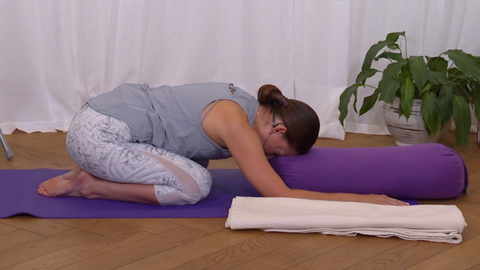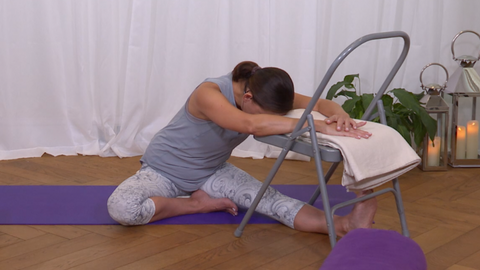This journal entry is brought to you by our friends at Movement for Modern Life; a fantastic community known in the industry as the Netflix of yoga.
Thank you to Kat and her team, for sharing their wisdom so generously.
And if you’re curious about their work, and their newly launched programme Menopause for Modern Life, head HERE to find out more.
With love, the MPowder Team.
—
“Yoga is a fantastic exercise for the entire body. It can improve some of the symptoms of the menopause, including sleep disturbance, fatigue, low mood, and anxiety. Some women find it helps to reduce hot flushes too.” Dr Louise Newson
Yoga can improve some of the physical, emotional, and psychological symptoms that we face with menopause. The process of menopause can be an unsettling time as our body undergoes significant hormonal changes, it is not a time to push or force, so remember to practice yoga in a way that best supports your emotional and physical needs. Your yoga practice can be a time for you to rest, release, let go and nurture yourself.
How can yoga support me through menopause?
-
Improves Muscle Tone and Bone Density. Stronger forms of yoga help us maintain flexibility, overall strength and improve balance - all vital for preventing falls and bone fractures.
-
Reduces Hot Flushes. The calming effect of yoga and breath work practices can help to lower the body temperature. In Indian Ayurveda, hot flushes are viewed as an excess of heat (pitta), pitta is our fiery energy of doing. Our yoga practice helps us to rebalance this energy and cool our fire as we slow down and do less.
-
Relieves Anxiety and Stress. The meditative and mindful side of yoga helps us stay in the present moment; relieving anxieties related to change. Doing some of these practices before bed can also improve your sleep quality.
-
Improves Pelvic Floor Strength. Core strengthening exercises such as boat pose or yogi bicycles, often found in stronger vinyasa practices, can improve pelvic floor muscles.
-
Eases Aches and Pains. Moving your body mindfully and in accordance with its needs can help lubricate the fascia and create a feeling of more space in tight joints.
The following poses and breathing practice can help with cooling and calming your body, and soothing your nervous system. Doing these practices for 15 minutes a day has been proven to provide some relief from your night sweats, hot flushes and menopausal irritability.
You will need: a chair, a bolster, bricks, blankets, and an eye pillow. You can get creative with your props based on what you have available at home; a thick book makes a great brick, for example!

Paced Breath
Normally we take around 15 breaths a minute; with this practice we half the amount of breaths we take to slow down the nervous system. Start by sitting comfortably upright on a cushion or bolster and notice the flow of your breath – observe the depth, temperature and rhythm. Inhale to a count of four, then gradually release the breath for eight counts. Continue this new breathing rhythm (4 in, 8 out) for as long as feels comfortable. When finished, allow the breath to return to its normal pattern and take a moment to observe how you feel.

Supported Downward Facing Down
Take your hands to either side of the bolster and spread your fingers wide. Curl your toes under, lift your knees and hips. Start by keeping a deep bend in your knees. Lightly place your hairline onto the bolster (not the top of your head). If your head doesn’t reach, add cushions or blankets for support. Continue to lift your hips and engage the legs. By resting the head on the bolster, we activate the vagus nerve - the nerve that communicates to our brain that we are safe and well. This light activation is a powerful switch to turn on our rest and digest state.

Supported Child’s Pose
Bring your toes together and knees apart, rest your belly to the thighs and bring your head down to the rest on the bolster. Take a few breaths; notice the breath filling your ribs, expanding the diaphragm and sending breath down into the pelvic floor. Stay here for as long as feels good!

Wide Leg Standing Forward Fold
Bring a chair in front of you, place your hands on your hips and take a wide stance with your legs. Inhale to lift your chest and exhale to fold forward, bringing your hands to the floor or onto your blocks. Inhale to lengthen into a flat back and exhale to bend your elbows and release your forehead to the seat of the chair (with the blanket on top). You have the option to rest your hands on the seat of the chair (this can relieve some pressure on the shoulders). Stay here and breathe for 1-2 minutes, focusing on a long slow exhale, activating the vagus nerve. When you are ready to come out, inhale to a flat back, and with a soft bend in your knees slowly come back up and return to mountain pose.

Supported Janusirsasana
Extend your left leg straight, bring the sole of your right foot to the inner groin of your left leg. Turn your torso to face over your extended leg. Place the chair in front of you and as you inhale lift and lengthen, as you exhale fold forward to rest your forehead on the chair. Soften your shoulders and gently breathe; nourishing the reproductive organs and creating a sense of calm and grounding. Witness the temperature of the body, the heart rate and blood pressure all lower.
Stay here and breathe for at least one minute on each side.

Seated Open Twist
Sit on a blanket or cushion for extra support and extend your legs straight. Bring the left knee into your chest and place your left elbow inside your knee. Place your right fingertips behind you and inhale to lift your spine, exhale to gently turn and gaze over the right shoulder. Continue to ride the waves of the breath and let go of anything that doesn't serve you. Repeat on the other side.

Restorative Inversion
Place a blanket on the chair for cushioning and sit on a bolster just in front of the chair. Place your calves onto the chair and shuffle your sit bones slightly forwards, use your hands to help you slowly lower down, bringing your upper back and head to the floor. The back of your shoulders softens to the floor, hands rest down by your sides. Place an eye pillow over your eyes and hold for 5-10 minutes, feeling the cooling and calming benefits on your nervous system. If you are menstruating or have sensitivity in your lower back, you can remove the bolster and lower down onto your back.
Free Class:
https://movementformodernlife.com/yoga-for-menopause
This cooling and calming yoga class and breath practice soothes the nervous system and deeply relaxes the mind and body, suitable for anyone feeling overwhelm or the need to calm. But this class especially is a great menopause yoga class, providing relief to hot flushes, night sweats, irritability and sleeplessness. In addition to supported forward folds, gentle inversions and restorative poses, there is slow deep breathing and cooling pranayama practices. This sequence is recommended for anyone feeling overwhelmed or stressed, or anyone experiencing menopausal symptoms, especially if you are experiencing excessive heat in the body and to mitigate the effects of hot flushes, night sweats and irritability. A soothing practice to do in the evening before bed.
Share Twitter Facebook Pinterest

